If there is one astonishing fact about the 20th century that will bewilder historians of the future, it is that the nations of the world, the United States of America and Russia in particular, invested trillions of dollars in nuclear weapons without putting them to serious use against the other. Yes, the United States did batter Nevada into submission with approximately a thousand nuclear detonations. Presumably the Russians did something analogous to their own subject territories. And yet, the long promised global thermonuclear war has never quite come to pass.
Nor is this weird sense of potential going unfulfilled peculiar to writers struggling to come up with enough words for a Tor.com essay! Game company Fria Ligan knows this market; it has just released the 4th edition of the venerable Twilight 2000 tabletop roleplaying game (newly out today), which offers players the chance to escape to a world in which international tensions spiraled into nuclear conflict in the mid-1990s. Forget work deadlines, forget tax forms, forget worriedly checking the Covid numbers in your area! It’s much more fun to spend your time searching for a trove of faintly glowing food tins so that your character doesn’t starve before the fallout kills them.
Perhaps it’s no wonder, then, that science fiction and thriller authors have been more than willing to provide us with the dubious wonders that could be ours, given only the resolve to press The Button1 . Consider these five Cold War works.
Shadow on the Hearth by Judith Merril (1950)
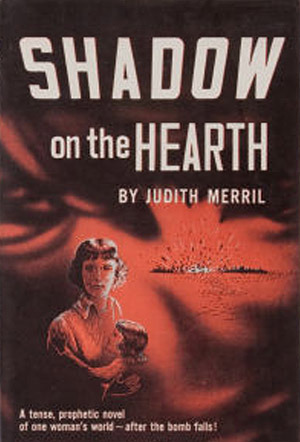
On a seemingly unremarkable mid-century day, Gladys kisses her work-bound husband Jon goodbye and struggles to manage her Westchester household without her dutiful maid Veda. Conventional domesticity comes to an abrupt, unpleasant halt when an unnamed enemy detonates nuclear devices in major American cities, including the New York City where Jon works. Official broadcasts assure Americans that the crisis is well in hand, that US defenses are now utterly impenetrable, and that victory over the unnamed enemy is certain. All people like Gladys need to do is obey the government and trust that a better day will soon come.
Official optimism is little comfort to Gladys. The rudimentary communications of the day have been shattered by the attack, as have commercial supply chains. Gladys is left to care for her children with no idea when Jon will return—if he was not incinerated along with so many New Yorkers. She won’t know whether fallout will reach Westchester, whether food will be available for her and her children, or even if the sunny proclamations from the government are accurate or merely bare-faced lies.
She has a household to keep alive—a challenge from which she does not flinch.
Dark December by Alfred Coppel (1960)

Major Kenneth Gavin did his bit in World War Three, sending missile after missile towards the Soviets from the Unimak Island Titan missile base. Somehow, Soviet counter-strikes failed to obliterate Unimak (nearby Dutch Harbor was not so lucky). The United States having prevailed over Russia, Gavin is released from military service to return to San Francisco, where his wife Sue and daughter Pam wait. Or so he hopes.
That’s IF Gavin can find his way to Klamath Falls, purchase a horse and cross the radioactive wasteland between Gavin and whatever remains of San Francisco. IF Sue and Pam are even still alive (news no longer trickles out of lost zones like the US West Coast). IF Gavin can elude the deranged Collingwood, who blames Gavin for the end of Collingwood’s career. IF Gavin can survive in a violent world, even if he is so sickened by violence that he refuses to defend himself when attacked.
Pulling Through by Dean Ing (1983)
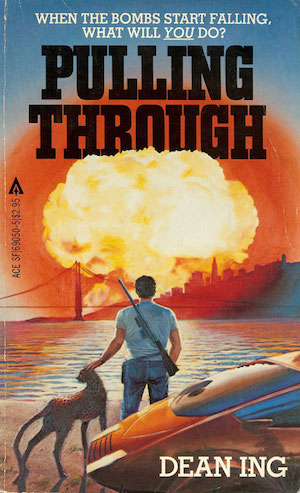
Bounty hunter Harve Rackman is prudent and prepared. Thus, when he learns that Soviet-built Syrian fighter-bombers have nuked US forces in the Mediterranean, he does not wait to see if the situation will escalate into a full-scale exchange before fleeing the Bay Area. He doesn’t have to worry about having a safe destination: his Contra Costa County shelter awaits!
Having survived the first exchange, a new challenge arises. Harve’s sister Shar and her family never arrived at Harve’s shelter. Prudence dictates that Harve wait until the radioactivity dies down. Family loyalty compels him to head out into the chaos in the slender hope that Shar, her husband, and her children are still alive, that he can find them and somehow—despite fallout, panicked refugees, and blocked roads—bring them back to his shelter.
(The Ace edition of this book comes with a How To guide for building survival gear out of simple household materials.)
The Third World War: August 1985 by General Sir John Hackett (1978)
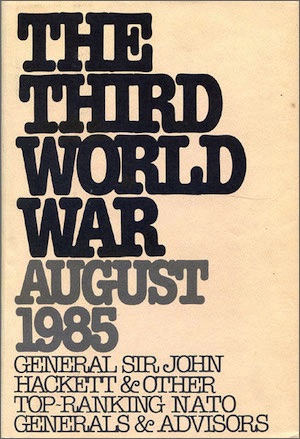
Fearing that the nations of the Warsaw Pact are slipping out of Soviet control, the USSR does what anyone would do in their position and launches an invasion of West Germany. After all, there is nothing like a joint external enemy to unify a troubled alliance. Swift victory over NATO will ensure unity amongst the Soviet Union’s rebellious allies. At least, that’s the theory.
The reality is that NATO foresaw the coming war and was prepared. Red conventional forces cannot deliver victory over NATO. Indeed, those forces may not be sufficient to forestall defeat or to prevent unhappy Warsaw Pact governments from considering whether they have more to fear from NATO than they from Moscow. Having exacerbated existing tensions within their alliance, the Kremlin can think of no better course than to embrace the nuclear option.
Hackett’s book was unusual in that a number of other authors wrote their own works in the same universe: Ing’s System Shock, Coyle’s Team Yankee, and Bob Forrest-Webb’s Chieftains. Note that Forrest-Webb takes a rather dim view of an armored unit’s prospects of making through WWIII.
Trinity’s Child by William Prochnau (1983)
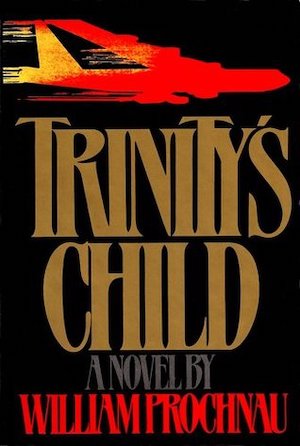
Rather than continue to fund expensive defenses against the American nuclear arsenal, the Politburo resolves to save money by launching a first strike against United States’ military assets. The Soviet premier believes that this would be tantamount to national suicide as it would invite a full-scale response; he resists, first by delaying the attack, then by launching a much reduced attack, on a scale that would kill perhaps nine million Americans. This is accompanied by a telegram to the US President explaining the premier’s goals, delivered minutes before an incoming missile is slated to strike somewhere near Washington, DC.
US bomber forces caught on the ground will be destroyed, as will US Trident bases. Some ICBM sites are targeted. The point is not to reduce the US to helplessness, but to make the precariousness of the world situation clear at what is considered an acceptable cost of only fifteen to twenty million lives worldwide.
It’s a plan as bold as it is deranged.2 The American president can order a proportionate response, but once the nuclear warheads start detonating, there is no way to ensure that the exchange will not escalate. After the president’s apparent death, command devolves to the Secretary of the Interior, the senior-most surviving official in the ladder of succession. He is a man to whom command should not be entrusted. A full-scale nuclear exchange seems inevitable.
Polar Bear One, one of the few bombers to escape the Soviet attack, is heading over the pole. Filled with nuclear weapons, the plane is a potent weapon of war. It is the last place to which one might look for a hope of stopping the escalation. Nevertheless, the plane’s crew may be the last chance of avoiding apocalypse.
***
No doubt you have your own favourites not mentioned above (or here. Or here. Or here. What can I say? I was a Cold War kid and this is a topic close to my heart). Please feel free to mention them below.
In the words of Wikipedia editor TexasAndroid, prolific book reviewer and perennial Darwin Award nominee James Davis Nicoll is of “questionable notability.” His work has appeared in Publishers Weekly and Romantic Times as well as on his own websites, James Nicoll Reviews and the Aurora finalist Young People Read Old SFF (where he is assisted by editor Karen Lofstrom and web person Adrienne L. Travis). He is a four-time finalist for the Best Fan Writer Hugo Award and is surprisingly flammable.
[1]The Button is a metaphor. In reality, there’s a whole process involved that is more complicated than just pressing a single button. Given the human propensity for absent-mindedly setting down coffee cups in the wrong place, this may be for the best.
[2]Perhaps believing that audiences would never buy the novel’s premise, when “Trinity’s Child” was adapted to film as “By Dawn’s Early Light,” the cause of the exchange is changed from the not especially plausible premise described above to an attack instigated by rogue Soviet elements. A minor mystery I will never solve: as “Trinity’s Child” begins, the president is watching a “Mission: Impossible” rerun. “Mission: Impossible” actor Martin Landau is mentioned by name. Did this play any role in casting Landau as the president in “By Dawn’s Early Light”?










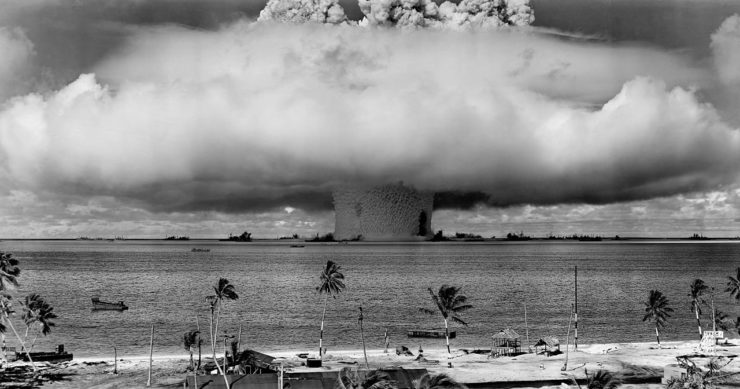
My obvious go-to story about after the nuclear war is A Canticle for Leibowitz by Walter M. Miller (1959)- discussed of course in a previous post.
So what I want to know based on the cover of Pulling Through is– How did Harvey Rackham get a pet cheetah? What’s the Cheetah’s name? What does a pet cheetah do for food after a nuclear holocaust? When he goes off to save his family does he take the cheetah with him or does leave plenty food and water in the bunker, along with a giant litter pan? DOES THE CHEETAH SURVIVE IN THE END?
Personally I’d name the cheetah Spots or Speedy.
Harve has Spot the cheetah from the beginning and while not all the characters survive (the US is down to 80 million people by the end of the story), Spot does.
The interesting thing about Hackett’s work is that, the specific issue of the triggering event aside, it pretty accurately predicted how the Soviet Union/Warsaw Pact would fall apart rapidly and without a significant attempt at armed suppression of the internal collapse. At the time it seemed rather unlikely.
I have that Ace edition of Pulling Through. Intro by Spider Robinson, iirc. Wasn’t there a sequel? I recall seeing it, but not reading it.
I think Alas Babylon was the first in that genre I read, when I was 12 or so. Living in McLean Virginia with primary targets all around I had no illusions about my chances
Weren’t John Wingate’s trilogy of WWIII naval novels, Frigate, Carrier, and Submarine, set in General Hackett’s background too? I read them around then, and they were really quite disturbing…
Also UK SF writer David Mace wrote a couple of novels set in the ruins of a mind 21st century hot nuclear war, Fire Lance and Demon 4. The latter was (at least I remember it being) rather good, the story of a cyborg submarine attempting to disarm a robot fortress under the sea near Antartica.
@3, Good! Who cares about the people, the beautiful cheetah must live!
I understand that cheetahs are the only great cats who can be reliably tamed.
The only thing I can remember about Hackett’s The Third World War was the comment from my mate at uni who said, essentially, that he got about three pages into it, read the line that described the Shah of Iran as the most stable US ally in the region, and threw the book across the room.
Anyway, there’s always the venerable On the Beach. Not to mention Fail Safe. Both were, of course, made into fab films.
I think we can all agree that the true horror is Twilight 2000 and 2300CE being under different roofs.
I was surprised to see that Pat Frank’s Alas, Babylon did not make your list.
The casting director for “By Dawn’s Early Light” was Junie Lowry-Johnson (Facebook link). Perhaps you can ask her?
In the same vein as The Third World War: August 1985 is Tom Clancy’s Red Storm Rising. I think it’s the only novel of his that didn’t relate to Jack Ryan in some way.
Two things about the novel struck me. First, it’s not enough to call your opponent evil. You still need to understand your opponent’s motivation. Why are they attacking?
Second, in Tom Clancy’s world, they managed to avoid using nukes in a war between the USSR and NATO. Which I suppose is hopeful for the mid 1980s.
@7 – if no people survive, why is it important that cheetahs can be tamed?
Because the intelligent raccoons with have pigs to ride into battle, so the intelligent cats will need their own cavalry.
#9 – took me a minute to get the ref. Loved 2300 when I was a teen, the Near Star Map, the beanstalk, the Kafers.
Like many my first dose of this stuff was Alas, Babylon. Gotta love a 5 MPH car chase. My folks had a copy; maybe they bought it in the wake of The Day After? By Dawn’s Early Light is a pretty good flick, you can watch it on YT I believe. Red Storm Rising fits in with the books here, too.
@13, It’s not. I just think pet cheetahs are cool.
@12 Red Storm Rising is the novelisation of a wargame (or rather, two); Larry Bond’s Convoy-84 and his Harpoon rules which Clancy also used when writing The Hunt For Red October. He’s credited as co-author.
A few more:
Philip K. Dick, 1965: Dr. Bloodmoney: or, How We Got Along After the Bomb.
and of course its 1958 predecessor Peter George: Red Alert, (the basis for Kubrick’s Dr. Strangelove: or, How I Learned to Stop Worrying and Love the Bomb); published in Britain as Two Hours to Doom under the passoodonimm of Peter Bryant — whose premise was so similar to that of Burdick and Wheeler’s 1972 Fail-Safe that the latter settled out of court for copyright infringement (Isn’t Wikipedia wonderful, boys and girls?)
Weirdly, the “Shannara” novels appear to take place two thousand years after a nuclear holocaust.
Mordecai Roshwald (1959): Level 7. I haven’t read this one (or more than a few pages of the first Shannara book, come to think of it), but I remember seeing it on bookstore shelves and thinking real hard about it.
My favorite in this subgenre is On The Beach– let’s all die with our chins up! For a couple more, I will toss in David Palmer’s Emergence, and The Texas-Israeli War: 1999, by Jake Saunders and Howard Waldrop. (I always wondered how either group survived a nuclear war- surely someone would have felt the need to sling bombs in each direction)
In the Saunders/Waldrop, there had been a nuclear disarmament treaty prior to the war. However, there were still lots of nukes left, not to mention bioweapons, so the population remaining was down to a few hundred million.
There was a 1980s series by James Rouch called The Zone detailing a long war fought with hovertanks and other SF-nal hardware in a large chunk of central Europe contaminated by nukes and chemical weapons. I thought that Rouch would turn out to be a pseudonym but it appears not, doesn’t appear to have written much other than military fiction. Review of the first book here:
https://fuldapocalypsefiction.com/2019/07/16/review-the-zone-hard-target/
For a more post-apocalyptic* setting there’s always the Judge Dredd universe, where large swathes of the USA and the rest of the world (more or less everywhere outside the surviving Megacities) are irradiated and full of mutant animals and cannibals. Not a fun place even for the mutant animals and cannibals…
* large parts of Megacity One and other Megacities has been nuked since the series began, so maybe post isn’t quite the right word, it’s more of an ongoing process.
@21 – I forgot Zelazny’s Damnation Alley, which inspired the Cursed Earth and other radiation zones of Judge Dredd.
The movie of Damnation Alley is famously terrible but it does feature the only example I know of a major American military base being destroyed by, I am not making this up, a issue of Playboy.
Greg Bear’s Eternity deals with the aftermath of a nuclear war (the earlier Eon takes place shortly after a small nuclear exchange and well after a huge one – it’s complicated).
Philip Wylie’s Tomorrow! looks at the effects of a nuclear blast on twin cities – one that took civil defense seriously and one that didn’t
Zero for five here. No mention of “On The Beach”, “The Road”, “Alas, Babylon”, “Farnham’s Freehold”, or “Snow and Ash: Endless Winter”.
This list is sadly incomplete without Alas, Babylon, The Earth Abides, and On the Beach.
The Earth Abides isn’t post nuclear and the other two were mentioned in the older essays I linked to.
(26) Earth Abides by George R, Stewart is one of my favorite books. It takes place after a highly lethal pandemic, not a nuclear exchange.
I read “Z for Zachariah” as a ten year old and remember being horrified by the premise. This was in the late 80s tho and in Australia, so comfortably (?) out of Cold War territory.
Farnham’s Freehold would fill a much-needed gap in this list.
Robert Merle’s 1972 Malevil is yet another story of survival after a nuclear war. This time, in a French castle. Wasn’t a bad read, but it’s been quite a while.
Phillip Wylie’s ironically named Triumph deals the struggle for survival of the handful of known survivors of a full scale Soviet US nuclear exchange, a millionaire, his daughter, her boyfriend/fiance and some other characters I don’t remember after 30 years. SPOILER: They are eventually evacuated from their Connecticut fallout shelter by the Australians.
I particularly remember Wylie’s lovingly detailed description of how the Soviet attack was designed to kill everyone and wreck the land afterwards. It started with sodium jacketed nuclear mines offshore which produced large amounts of extremely radioactive gas with a short half life. The conclusion was a general plastering of the entire country with cobalt and other long lived radioactive byproducts. We never hear about the retaliatory assault by the US, but apparently there is no Soviet Union worth mentioning by the end of it.
Out of print now, although a handful of used copies are offered at Amazon.
@18 Dan’l – Glad to see someone mentioned Mordecai Roshwald’s Level 7
I read it at college about 30 years ago and it still haunts my mind to this day, there is not a week that goes by that I don’t think about it someway, even down to “Press the Button!!”.
Sometimes I think I should read it again but then again do I want to read something that so successfully screwed with my mind all those years ago?
The Chrysalids (1955; in the US, Rebirth) by John Wyndham. Centuries after the war, people are scrabbling out a life in Newfoundland, under the religious injunction “Watch thou for the mutant!” This is awkward for the narrator, who is a telepath.
In Zelazny’s “…And Call Me Conrad” (published with cuts restored as This Immortal), people occasionally visit the mainland but live largely on the islands due to the aftereffects of massive bombing (e.g., the Nile is rife with boadiles), although IIRC we’re never told who the antagonists were.